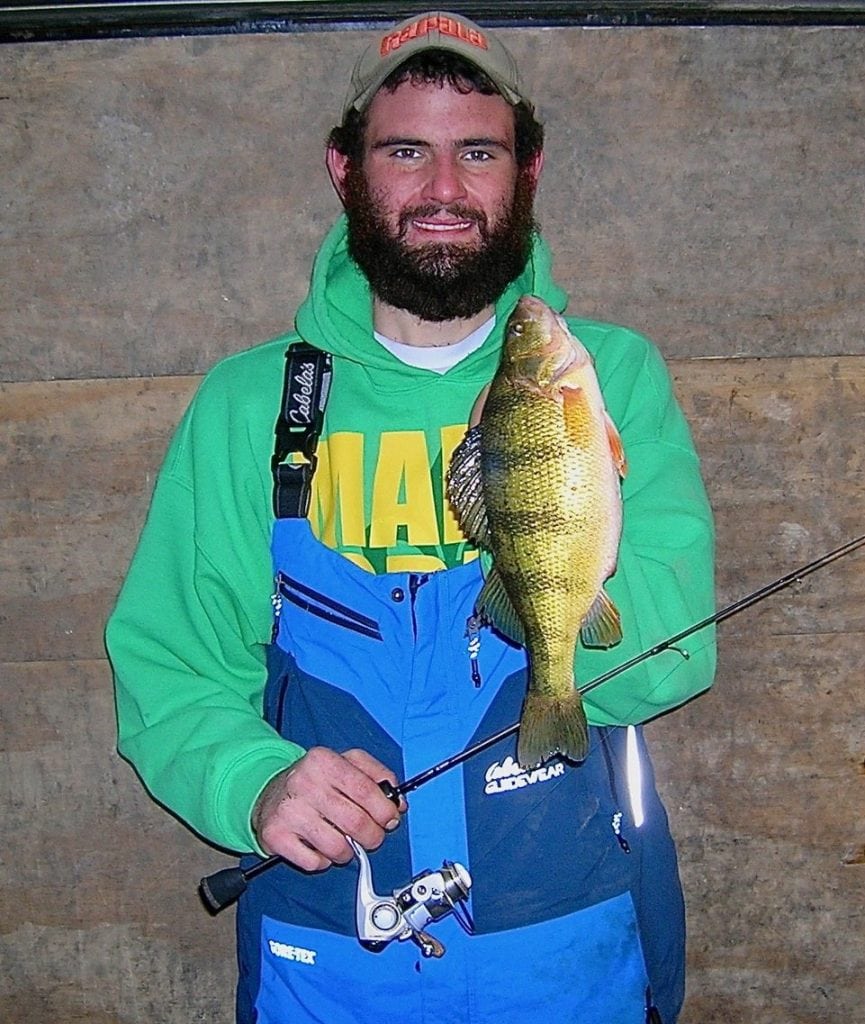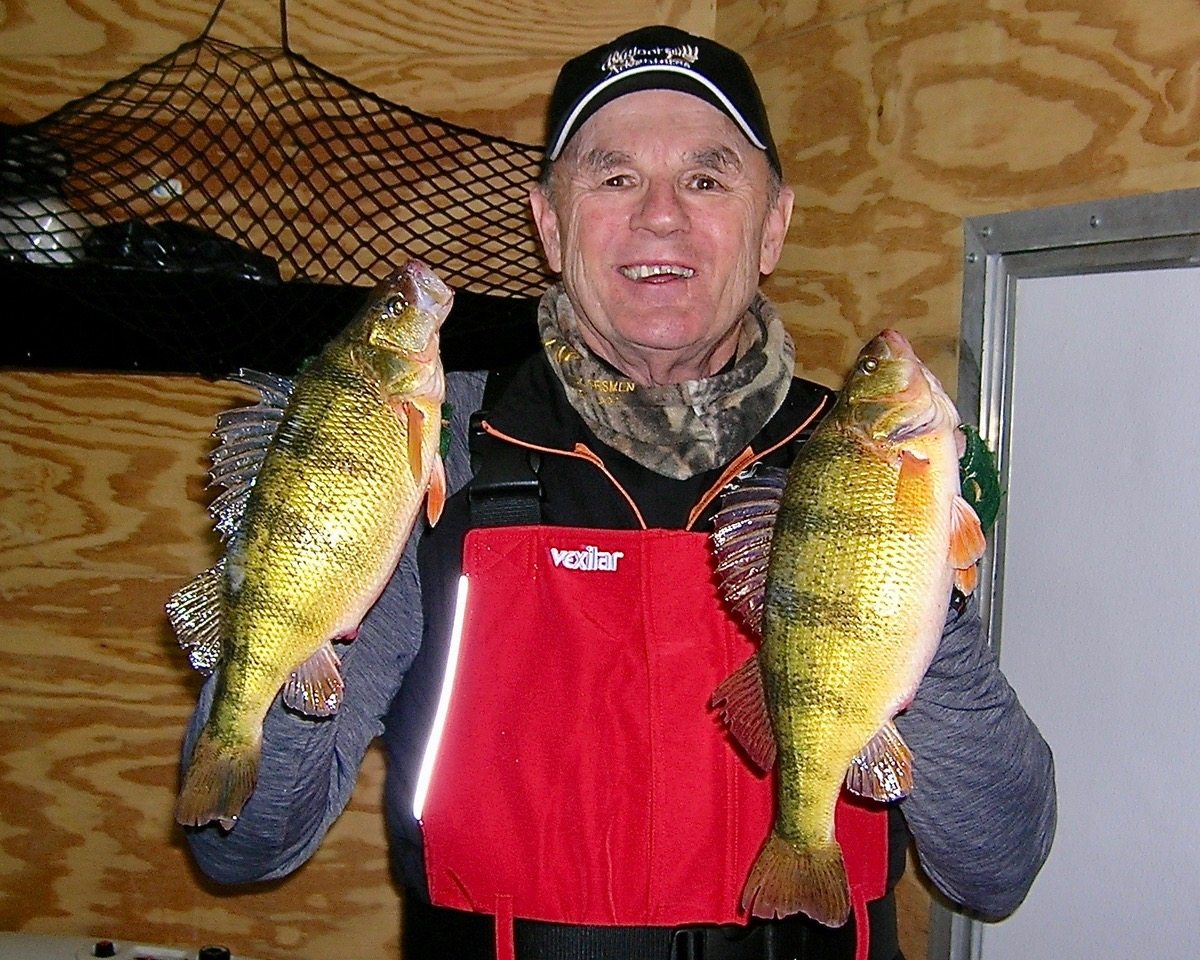We arrived in Webster, South Dakota the afternoon before we were to be on the ice and spent a leisurely afternoon eating lunch at Perebooms and stopping at Sportsman’s Cove to see where the best bite was and what baits the anglers were using.
I always like to know what the main forage species is on the waters we will fish, on the Glacial Lakes of N.E. South Dakota, the freshwater shrimp are plentiful and what the perch feed on, so I try to find small bait that resembles the small shrimp or baits that is similar in color.
Some anglers were using Wax Worms, but those catching the most perch seemed to be partial to Red Wigglers on their baits and to be on the safe side we grabbed both wigglers and wax worms just in case the fish had changed their diet.
I also added several white tungsten jigs and jigging spoons to my tackle bag, hoping that they would be the bait that the perch were after.
Then we unloaded our extra gear at Boomer’s Motel, ordered a pizza and spent the evening watching one of the best Super Bowl games either of us had ever seen.
The following morning, we talked with our guide who indicated we would start fishing on Reid Lake, one of the hundreds of shallow Glacial Lakes found throughout the region. Reid is a nine hundred and eighty acre lake that lies southwest of Webster, South Dakota.
Arriving at the lake, the wind was howling, bringing the wind chill down well below zero and we were glad we did not have to fish out of the two-man sled in the back of my pickup.
Our guide, Brandyn Hulsebus, one of the guides with Cory Ewing’s Waubay Lakes Guide Service had set up the icehouse we would be fishing out of before our arrival and had everything ready to go when we pulled onto the lake.
It was mid season with several fronts having moved through the area, which could be devastating when it comes to ice fishing as the fronts affect the barometric pressure and when it is up as it is when fronts move through it has a tendency to slow the bite.
Fortunately, for us, Cory and his guides had spent time on ice locating areas the perch were coming into.
When we get into the house, we set up our Vexilar locators and started jigging using Red Wigglers as that was what the perch were biting on. When we first get on a lake, each of us go with different baits, as this allows the fish to tell us what they like.
Once we land several fish on a certain bait, the others in our group will switch to that bait until the fish quit biting and then use an attractor bait, a jigging spoon, Jiggin Rap or some bait with a lot of action to pull the fish in while the others in our party all put down different baits.
Larry and I would be using two and four-pound Berkley ice line with tungsten jigs. While, Brandyn would use his jigging spoon to draw the fish in.
The attractor spoon would bring the fish in, allowing us to catch one or two of the aggressive biters from the school and then we switched to our tungsten lures, allowing us to use smaller yet heavier baits that dropped quickly. Using them allowed us to getting our baits down and not waste any time when the perch were below us.
Perch have a tendency to school according to size with the smaller perch being more aggressive than those found in larger schools.
The bite had slowed since the week before, so we had to earn each fish, but those fish we took were good size, in the eleven to thirteen and a half inch range.
Brandyn would be fishing beside Larry on the south end of the house while I fished the north end near the door.

Brandyn Hulsebus, a guide with Cory Ewing’s Waubay Lakes Guide Service, with a chunky Glacial Lakes Perch. (Larry Myhre photo)
Our guide was the first to land a chunky eleven-inch perch on his jigging spoon, while Larry and I using or small jigs, each picked up one shortly after that.
Perch like to roam, the body of water they are in, swimming around in schools according to size, stopping here and there to check things out before coming around and setting up back under our house. In these schools, the smaller perch are more aggressive and more apt to take your bait than those schools holding the larger perch.
When it comes to perch fishing, it amazes me why one hole that is only a few feet away from another will be the most active.
My son and I found this out years ago when fishing a Nebraska lake; we were using identical tackle with the hole I was fishing, less than a foot for two from his. I was catching fish, and he was not, being the energetic young kid whose always thinking, once I pulled a perch out he would drop his line down the hole I was fishing and catch a perch before I had time to re-bait.
After we landed a few fish on Reid, the bite slowed and Brandyn contacted Cory who was on the ice with another group of anglers. They were fishing on an unnamed slough about ten miles from the lake we were on and doing quite well, so we decided to make the move.
Brandyn loaded up our house and we traveled down the road to where the other group was fishing. It proved to be a smart move, as we would take some of our larger perch on this slough.
Our guide along with the icehouse would take the lead, with Larry and I following and once we arrived, it did not take Brandyn long to get the house set up.
Brandyn cleared the ice from the hole Larry would fish from and Larry quickly set up and had his tungsten jig down before I or Brandyn could get the ice out of the other holes.

Author with two of the perch taken while ice fishing in northeastern South Dakota. (Larry Myhre Photo)
It didn’t take him long to pop his first fish, one of the smaller fish roaming the waters of the slough and one that was put back allowing it to hopefully grow to trophy size.
Brandyn, using his jigging spoon, attracted several perch and it did not take him long to catch a keeper. As he was unhooking his fish, both Larry and I each landed nice keepers.
Meanwhile, one of Cory’s other guides was on the move trying to locate large schools of perch, using his pickup as his icehouse. With his GPS mounted on his dash, allowing him to mark different locations on the ice the perch were using. Mounted in the pickup door was his Vexilar locator, which let him stay out of the weather while he fished from his pickup.
Once again, Cory’s Waubay Lakes Guide Service, with guide Brandyn Hulsebus putting us on fish where the tungsten jigs outperformed other baits, as they allowed is to get down quickly to the bottom and to keep our baits in the fish-catching zone longer.
The bite was not fast, but the perch we caught were good ones, ones once we got home would go into the pan, making our Lenten meals very enjoyable.
If you are looking for some excellent fishing, no matter the season, contact Team Outdoorsmen Adventures Member Cory Ewing and his Waubay Lakes Guide Service as they are on the water and ice throughout the year and know where the bite is.
You can contact Cory by phone at 1-605-929-3894, on line at www.waubaylakeguideservice.com or via email at cory_ewing@waubaylakeguideservice.com.
When Team Outdoorsmen Adventures and Gary Howey’s Outdoorsmen Adventures television fish and film in the Webster area, they stay at Boomers Outback, Boomer’s Hotel and dine at Perebooms restaurant, check out their website at www.boomersoutback.com.





0 Comments